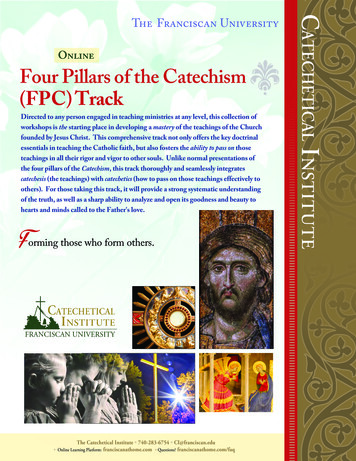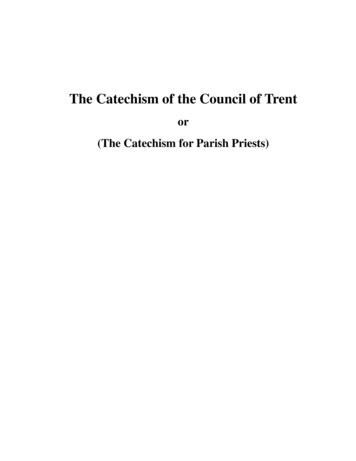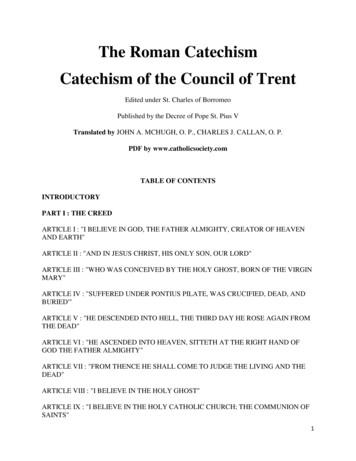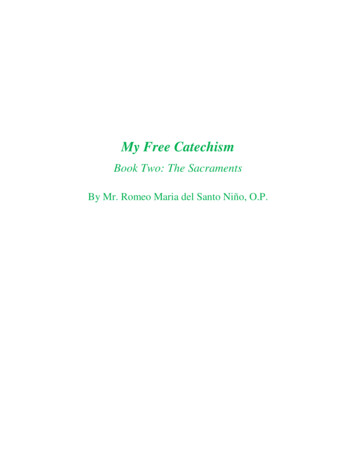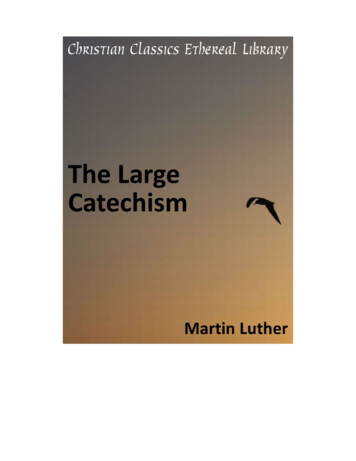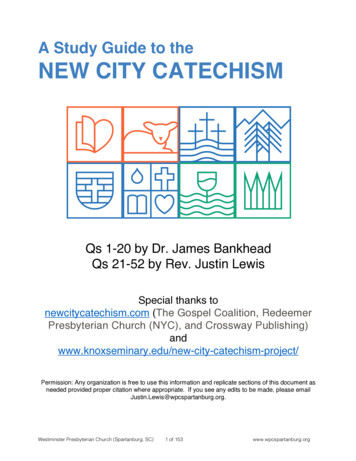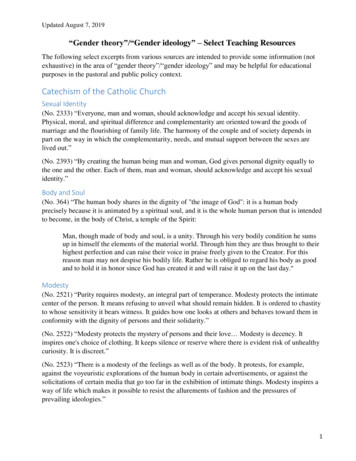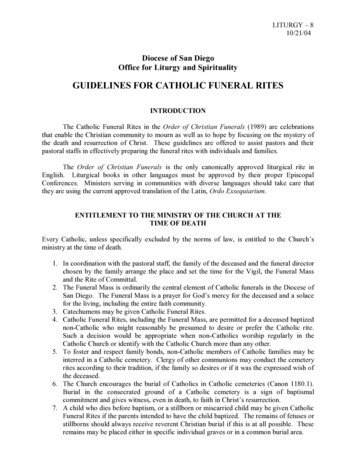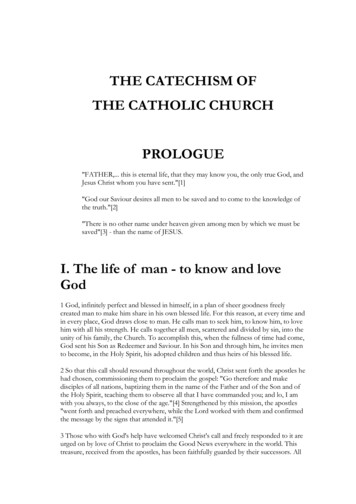
Transcription
THE CATECHISM OFTHE CATHOLIC CHURCHPROLOGUE"FATHER,. this is eternal life, that they may know you, the only true God, andJesus Christ whom you have sent."[1]"God our Saviour desires all men to be saved and to come to the knowledge ofthe truth."[2]"There is no other name under heaven given among men by which we must besaved"[3] - than the name of JESUS.I. The life of man - to know and loveGod1 God, infinitely perfect and blessed in himself, in a plan of sheer goodness freelycreated man to make him share in his own blessed life. For this reason, at every time andin every place, God draws close to man. He calls man to seek him, to know him, to lovehim with all his strength. He calls together all men, scattered and divided by sin, into theunity of his family, the Church. To accomplish this, when the fullness of time had come,God sent his Son as Redeemer and Saviour. In his Son and through him, he invites mento become, in the Holy Spirit, his adopted children and thus heirs of his blessed life.2 So that this call should resound throughout the world, Christ sent forth the apostles hehad chosen, commissioning them to proclaim the gospel: "Go therefore and makedisciples of all nations, baptizing them in the name of the Father and of the Son and ofthe Holy Spirit, teaching them to observe all that I have commanded you; and lo, I amwith you always, to the close of the age."[4] Strengthened by this mission, the apostles"went forth and preached everywhere, while the Lord worked with them and confirmedthe message by the signs that attended it."[5]3 Those who with God's help have welcomed Christ's call and freely responded to it areurged on by love of Christ to proclaim the Good News everywhere in the world. Thistreasure, received from the apostles, has been faithfully guarded by their successors. All
Christ's faithful are called to hand it on from generation to generation, by professing thefaith, by living it in fraternal sharing, and by celebrating it in liturgy and prayer.[6]II. HANDING ON THE FAITH: CATECHESIS4 Quite early on, the name catechesis was given to the totality of the Church's efforts tomake disciples, to help men believe that Jesus is the Son of God so that believing theymight have life in his name, and to educate and instruct them in this life, thus buildingup the body of Christ.[7]5 "Catechesis is an education in the faith of children, young people and adults whichincludes especially the teaching of Christian doctrine imparted, generally speaking, in anorganic and systematic way, with a view to initiating the hearers into the fullness ofChristian life."[8]6 While not being formally identified with them, catechesis is built on a certain numberof elements of the Church's pastoral mission which have a catechetical aspect, thatprepare for catechesis, or spring from it. They are: the initial proclamation of the Gospelor missionary preaching to arouse faith; examination of the reasons for belief;experience of Christian living; celebration of the sacraments; integration into theecclesial community; and apostolic and missionary witness.[9]7 "Catechesis is intimately bound up with the whole of the Church's life. Not only hergeographical extension and numerical increase, but even more her inner growth andcorrespondence with God's plan depend essentially on catechesis."[10]8 Periods of renewal in the Church are also intense moments of catechesis. In the greatera of the Fathers of the Church, saintly bishops devoted an important part of theirministry to catechesis. St. Cyril of Jerusalem and St. John Chrysostom, St. Ambrose andSt. Augustine, and many other Fathers wrote catechetical works that remain models forus.[11]9 "The ministry of catechesis draws ever fresh energy from the councils. The Council ofTrent is a noteworthy example of this. It gave catechesis priority in its constitutions anddecrees. It lies at the origin of the Roman Catechism, which is also known by the nameof that council and which is a work of the first rank as a summary of Christian teaching. ."[12] The Council of Trent initiated a remarkable organization of the Church'scatechesis. Thanks to the work of holy bishops and theologians such as St. PeterCanisius, St. Charles Borromeo, St. Turibius of Mongrovejo or St. Robert Bellarmine, itoccasioned the publication of numerous catechisms.10 It is therefore no surprise that catechesis in the Church has again attracted attentionin the wake of the Second Vatican Council, which Pope Paul Vl considered the greatcatechism of modern times. The General Catechetical Directory (1971) the sessions ofthe Synod of Bishops devoted to evangelization (1974) and catechesis (1977), theapostolic exhortations Evangelii nuntiandi (1975) and Catechesi tradendae (1979), attestto this. The Extraordinary Synod of Bishops in 1985 asked "that a catechism or
compendium of all Catholic doctrine regarding both faith and morals be composed"[13]The Holy Father, Pope John Paul II, made the Synod's wish his own, acknowledgingthat "this desire wholly corresponds to a real need of the universal Church and of theparticular Churches."[14] He set in motion everything needed to carry out the SynodFathers' wish.III. THE AIM AND INTENDED READERSHIPOF THE CATECHISM11 This catechism aims at presenting an organic synthesis of the essential andfundamental contents of Catholic doctrine, as regards both faith and morals, in the lightof the Second Vatican Council and the whole of the Church's Tradition. Its principalsources are the Sacred Scriptures, the Fathers of the Church, the liturgy, and theChurch's Magisterium. It is intended to serve "as a point of reference for the catechismsor compendia that are composed in the various countries".[15]12 This work is intended primarily for those responsible for catechesis: first of all thebishops, as teachers of the faith and pastors of the Church. It is offered to them as aninstrument in fulfilling their responsibility of teaching the People of God. Through thebishops, it is addressed to redactors of catechisms, to priests, and to catechists. It willalso be useful reading for all other Christian faithful.IV. STRUCTURE OF THIS CATECHISM13 The plan of this catechism is inspired by the great tradition of catechisms which buildcatechesis on four pillars: the baptismal profession of faith (the Creed), the sacramentsof faith, the life of faith (the Commandments), and the prayer of the believer (the Lord'sPrayer).Part One: The Profession of Faith14 Those who belong to Christ through faith and Baptism must confess their baptismalfaith before men.[16] First therefore the Catechism expounds revelation, by which Godaddresses and gives himself to man, and the faith by which man responds to God(Section One). The profession of faith summarizes the gifts that God gives man: as theAuthor of all that is good; as Redeemer; and as Sanctifier. It develops these in the threechapters on our baptismal faith in the one God: the almighty Father, the Creator; his
Son Jesus Christ, our Lord and Saviour; and the Holy Spirit, the Sanctifier, in the HolyChurch (Section Two).Part Two: The Sacraments of Faith15 The second part of the Catechism explains how God's salvation, accomplished oncefor all through Christ Jesus and the Holy Spirit, is made present in the sacred actions ofthe Church's liturgy (Section One), especially in the seven sacraments (Section Two).Part Three: The Life of Faith16 The third part of the Catechism deals with the final end of man created in the imageof God: beatitude, and the ways of reaching it - through right conduct freely chosen,with the help of God's law and grace (Section One), and through conduct that fulfils thetwofold commandment of charity, specified in God's Ten Commandments (SectionTwo).Part Four: Prayer in the Life of Faith17 The last part of the Catechism deals with the meaning and importance of prayer inthe life of believers (Section One). It concludes with a brief commentary on the sevenpetitions of the Lord's Prayer (Section Two), for indeed we find in these the sum of allthe good things which we must hope for, and which our heavenly Father wants to grantus.V. PRACTICAL DIRECTIONS FOR USING THISCATECHISM18 This catechism is conceived as an organic presentation of the Catholic faith in itsentirety. It should be seen therefore as a unified whole. Numerous cross-references inthe margin of the text (numbers found at the end of a sentence referring to otherparagraphs that deal with the same theme), as well as the analytical index at the end ofthe volume, allow the reader to view each theme in its relationship with the entirety ofthe faith.19 The texts of Sacred Scripture are often not quoted word for word but are merelyindicated by a reference (cf.). For a deeper understanding of such passages, the readershould refer to the Scriptural texts themselves. Such Biblical references are a valuableworking-tool in catechesis.20 The use of small print in certain passages indicates observations of an historical orapologetic nature, or supplementary doctrinal explanations.
21 The quotations, also in small print, from patristic, liturgical, magisterial orhagiographical sources, are intended to enrich the doctrinal presentations. These textshave often been chosen with a view to direct catechetical use.22 At the end of each thematic unit, a series of brief texts in small italics sums up theessentials of that unit's teaching in condensed formulae. These "IN BRIEF" summariesmay suggest to local catechists brief summary formulae that could be memorized.VI. NECESSARY ADAPTATIONS23 The Catechism emphasizes the exposition of doctrine. It seeks to help deepenunderstanding of faith. In this way it is oriented towards the maturing of that faith, itsputting down roots in personal life, and its shining forth in personal conduct.[17]24 By design, this Catechism does not set out to provide the adaptation of doctrinalpresentations and catechetical methods required by the differences of culture, age,spiritual maturity, and social and ecclesial condition among all those to whom it isaddressed. Such indispensable adaptations are the responsibility of particular catechismsand, even more, of those who instruct the faithful:Whoever teaches must become "all things to all men" (I Cor 9:22), to win everyone toChrist. . . Above all, teachers must not imagine that a single kind of soul has beenentrusted to them, and that consequently it is lawful to teach and form equally all thefaithful in true piety with one and the same method! Let them realize that some are inChrist as newborn babes, others as adolescents, and still others as adults in fullcommand of their powers. Those who are called to the ministry of preaching must suittheir words to the maturity and understanding of their hearers, as they hand on theteaching of the mysteries of faith and the rules of moral conduct.[18]Above all - Charity25 To conclude this Prologue, it is fitting to recall this pastoral principle stated by theRoman Catechism:The whole concern of doctrine and its teaching must be directed to the love that neverends. Whether something is proposed for belief, for hope or for action, the love of ourLord must always be made accessible, so that anyone can see that all the works ofperfect Christian virtue spring from love and have no other objective than to arrive atlove.[19]ENDNOTES1. Jn 17 3.
2. 1 Tim 2:3-4.3. Acts 4:12.4 Mt 28:19-20.5 Mk 16:20.6 Cf. Acts 2:42.7 Cf. John Paul II, Apostolic Exhortation Catechesi tradendae 1; 2.8 CT 18.9 CT 18.10 CT 13.11 Cf. CT 12.12 CT 13.13 Extraordinary Synod of Bishops 1985,. Final Report II B a, 4.14 John Paul II, Discourse at the Closing Of the Extraordinary Synod ofBishops 7 December 1985: AAS 78, (1986).15 Extraordinary Synod of Bishops 1985, Final Report II B a, 4.16 Cf. Mt 10:32; Rom 10:9.17 Cf. CT 20-22; 25.18 Roman Catechism, Preface II; cf. I Cor 9:22; I Pt 2:2.19 Roman Catechism, Preface 10; cf. I Cor 13 8.
PART ONE:THE PROFESSION OF FAITHSection One"I BELIEVE" - "WE BELIEVE"26 We begin our profession of faith by saying: "I believe" or "We believe". Beforeexpounding the Church's faith, as confessed in the Creed, celebrated in the liturgy andlived in observance of God's commandments and in prayer, we must first ask what "tobelieve" means. Faith is man's response to God, who reveals himself and gives himselfto man, at the same time bringing man a superabundant light as he searches for theultimate meaning of his life. Thus we shall consider first that search (Chapter One), thenthe divine Revelation by which God comes to meet man (Chapter Two), and finally theresponse of faith (Chapter Three).Chapter One MAN'S CAPACITY FOR GODI. THE DESIRE FOR GOD27 The desire for God is written in the human heart, because man is created by God andfor God; and God never ceases to draw man to himself. Only in God will he find thetruth and happiness he never stops searching for:The dignity of man rests above all on the fact that he is called to communion with God.This invitation to converse with God is addressed to man as soon as he comes intobeing. For if man exists it is because God has created him through love, and throughlove continues to hold him in existence. He cannot live fully according to truth unless hefreely acknowledges that love and entrusts himself to his creator.[1]28 In many ways, throughout history down to the present day, men have givenexpression to their quest for God in their religious beliefs and behaviour: in theirprayers, sacrifices, rituals, meditations, and so forth. These forms of religious expression,
despite the ambiguities they often bring with them, are so universal that one may wellcall man a religious being:From one ancestor [God] made all nations to inhabit the whole earth, and he allotted thetimes of their existence and the boundaries of the places where they would live, so thatthey would search for God and perhaps grope for him and find him - though indeed heis not far from each one of us. For "in him we live and move and have our being."[2]29 But this "intimate and vital bond of man to God" (GS 19 # 1) can be forgotten,overlooked, or even explicitly rejected by man.[3] Such attitudes can have differentcauses: revolt against evil in the world; religious ignorance or indifference; the cares andriches of this world; the scandal of bad example on the part of believers; currents ofthought hostile to religion; finally, that attitude of sinful man which makes him hidefrom God out of fear and flee his call.[4]30 "Let the hearts of those who seek the LORD rejoice."[5] Although man can forgetGod or reject him, He never ceases to call every man to seek him, so as to find life andhappiness. But this search for God demands of man every effort of intellect, a soundwill, "an upright heart", as well as the witness of others who teach him to seek God.You are great, O Lord, and greatly to be praised: great is your power and your wisdom iswithout measure. And man, so small a part of your creation, wants to praise you: thisman, though clothed with mortality and bearing the evidence of sin and the proof thatyou withstand the proud. Despite everything, man, though but a small a part of yourcreation, wants to praise you. You yourself encourage him to delight in your praise, foryou have made us for yourself, and our heart is restless until it rests in you.[6]II. WAYS OF COMING TO KNOW GOD31 Created in God's image and called to know and love him, the person who seeks Goddiscovers certain ways of coming to know him. These are also called proofs for theexistence of God, not in the sense of proofs in the natural sciences, but rather in thesense of "converging and convincing arguments", which allow us to attain certaintyabout the truth. These "ways" of approaching God from creation have a twofold pointof departure: the physical world, and the human person.32 The world: starting from movement, becoming, contingency, and the world's orderand beauty, one can come to a knowledge of God as the origin and the end of theuniverse.As St. Paul says of the Gentiles: For what can be known about God is plain to them,because God has shown it to them. Ever since the creation of the world his invisiblenature, namely, his eternal power and deity, has been clearly perceived in the things thathave been made.[7]
And St. Augustine issues this challenge: Question the beauty of the earth, question thebeauty of the sea, question the beauty of the air distending and diffusing itself, questionthe beauty of the sky. . . question all these realities. All respond: "See, we are beautiful."Their beauty is a profession [confessio]. These beauties are subject to change. Whomade them if not the Beautiful One [Pulcher] who is not subject to change?[8]33 The human person: with his openness to truth and beauty, his sense of moralgoodness, his freedom and the voice of his conscience, with his longings for the infiniteand for happiness, man questions himself about God's existence. In all this he discernssigns of his spiritual soul. The soul, the "seed of eternity we bear in ourselves, irreducibleto the merely material",[9] can have its origin only in God.34 The world, and man, attest that they contain within themselves neither their firstprinciple nor their final end, but rather that they participate in Being itself, which alone iswithout origin or end. Thus, in different ways, man can come to know that there exists areality which is the first cause and final end of all things, a reality "that everyone callsGod".[10]35 Man's faculties make him capable of coming to a knowledge of the existence of apersonal God. But for man to be able to enter into real intimacy with him, God willedboth to reveal himself to man, and to give him the grace of being able to welcome thisrevelation in faith.(so) The proofs of God's existence, however, can predispose one tofaith and help one to see that faith is not opposed to reason.III. THE KNOWLEDGE OF GOD ACCORDINGTO THE CHURCH36 "Our holy mother, the Church, holds and teaches that God, the first principle andlast end of all things, can be known with certainty from the created world by the naturallight of human reason."[11] Without this capacity, man would not be able to welcomeGod's revelation. Man has this capacity because he is created "in the image of God".[12]37 In the historical conditions in which he finds himself, however, man experiencesmany difficulties in coming to know God by the light of reason alone:Though human reason is, strictly speaking, truly capable by its own natural power andlight of attaining to a true and certain knowledge of the one personal God, who watchesover and controls the world by his providence, and of the natural law written in ourhearts by the Creator; yet there are many obstacles which prevent reason from theeffective and fruitful use of this inborn faculty. For the truths that concern the relationsbetween God and man wholly transcend the visible order of things, and, if they aretranslated into human action and influence it, they call for self-surrender and abnegation.The human mind, in its turn, is hampered in the attaining of such truths, not only by theimpact of the senses and the imagination, but also by disordered appetites which are theconsequences of original sin. So it happens that men in such matters easily persuadethemselves that what they would not like to be true is false or at least doubtful.[13]
38 This is why man stands in need of being enlightened by God's revelation, not onlyabout those things that exceed his understanding, but also "about those religious andmoral truths which of themselves are not beyond the grasp of human reason, so thateven in the present condition of the human race, they can be known by all men withease, with firm certainty and with no admixture of error". [14]IV. HOW CAN WE SPEAK ABOUT GOD?39 In defending the ability of human reason to know God, the Church is expressing herconfidence in the possibility of speaking about him to all men and with all men, andtherefore of dialogue with other religions, with philosophy and science, as well as withunbelievers and atheists.40 Since our knowledge of God is limited, our language about him is equally so. We canname God only by taking creatures as our starting point, and in accordance with ourlimited human ways of knowing and thinking.41 All creatures bear a certain resemblance to God, most especially man, created in theimage and likeness of God. The manifold perfections of creatures - their truth, theirgoodness, their beauty all reflect the infinite perfection of God. Consequently we canname God by taking his creatures" perfections as our starting point, "for from thegreatness and beauty of created things comes a corresponding perception of theirCreator".[15]42 God transcends all creatures. We must therefore continually purify our language ofeverything in it that is limited, imagebound or imperfect, if we are not to confuse ourimage of God--"the inexpressible, the incomprehensible, the invisible, the ungraspable"-with our human representations.[16] Our human words always fall short of the mysteryof God.43 Admittedly, in speaking about God like this, our language is using human modes ofexpression; nevertheless it really does attain to God himself, though unable to expresshim in his infinite simplicity. Likewise, we must recall that "between Creator andcreature no similitude can be expressed without implying an even greaterdissimilitude";[17] and that "concerning God, we cannot grasp what he is, but only whathe is not, and how other beings stand in relation to him."[18]IN BRIEF44 Man is by nature and vocation a religious being. Coming from God, going towardGod, man lives a fully human life only if he freely lives by his bond with God.45 Man is made to live in communion with God in whom he finds happiness: When Iam completely united to you, there will be no more sorrow or trials; entirely full of you,my life will be complete (St. Augustine, Conf. 10, 28, 39: PL 32, 795}.
46 When he listens to the message of creation and to the voice of conscience, man canarrive at certainty about the existence of God, the cause and the end of everything.47 The Church teaches that the one true God, our Creator and Lord, can be known withcertainty from his works, by the natural light of human reason (cf. Vatican Council I,can. 2 # 1: DS 3026),48 We really can name God, starting from the manifold perfections of his creatures,which are likenesses of the infinitely perfect God, even if our limited language cannotexhaust the mystery.49 Without the Creator, the creature vanishes (GS 36). This is the reason why believersknow that the love of Christ urges them to bring the light of the living God to thosewho do not know him or who reject him.ENDNOTES1 Vatican Council II, GS 19 # 1.2 Acts 17:26-28.3 GS 19 # 1.4 Cf. GS 19-21; Mt 13:22; Gen 3:8-10; Jon 1:3.5 Ps 105:3.6 St. Augustine, Conf. I, I, I: PL 32, 659-661.7 Rom 1:19-20; cf., Acts 14:15, 17; 17:27-28; Wis 13:1-9.8 St. Augustine, Sermo 241, 2: PL 38, 1134,9 GS 18 # 1; cf. 14 # 2.10 St. Thomas Aquinas, S Th I, 2, 3.11 Vatican Council I, Dei Filius 2: DS 3004 cf. 3026; Vatican CouncilII, Dei Verbum 6.12 Cf. Gen 1:27.13 Pius XII, Humani generis 561: DS 3875.14 Pius XII, Humani generis 561: DS 3876; cf. Dei Filius 2: DS 3005;DV 6; St. Thomas Aquinas, S Th I, I, I.15 Wis 13:5.
16 Liturgy of St. John Chrysostom, Anaphora.17 Lateran Council IV: DS 806.18 St. Thomas Aquinas, SCG 1, 30.CHAPTER TWO - GOD COMES TO MEET MAN50 By natural reason man can know God with certainty, on the basis of his works. Butthere is another order of knowledge, which man cannot possibly arrive at by his ownpowers: the order of divine Revelation.[1] Through an utterly free decision, God hasrevealed himself and given himself to man. This he does by revealing the mystery, hisplan of loving goodness, formed from all eternity in Christ, for the benefit of all men.God has fully revealed this plan by sending us his beloved Son, our Lord Jesus Christ,and the Holy Spirit.ARTICLE I - THE REVELATION OF GODI. GOD REVEALS HIS "PLAN OF LOVINGGOODNESS"51 "It pleased God, in his goodness and wisdom, to reveal himself and to make knownthe mystery of his will. His will was that men should have access to the Father, throughChrist, the Word made flesh, in the Holy Spirit, and thus become sharers in the divinenature."[2]52 God, who "dwells in unapproachable light", wants to communicate his own divinelife to the men he freely created, in order to adopt them as his sons in his only-begottenSon.[3] By revealing himself God wishes to make them capable of responding to him,and of knowing him and of loving him far beyond their own natural capacity.53 The divine plan of Revelation is realized simultaneously "by deeds and words whichare intrinsically bound up with each other"[4] and shed light on each another. It involvesa specific divine pedagogy: God communicates himself to man gradually. He prepareshim to welcome by stages the supernatural Revelation that is to culminate in the personand mission of the incarnate Word, Jesus Christ.St. Irenaeus of Lyons repeatedly speaks of this divine pedagogy using the image of Godand man becoming accustomed to one another: The Word of God dwelt in man andbecame the Son of man in order to accustom man to perceive God and to accustomGod to dwell in man, according to the Father's pleasure.[5]II. THE STAGES OF REVELATION
In the beginning God makes himself known54 "God, who creates and conserves all things by his Word, provides men with constantevidence of himself in created realities. And furthermore, wishing to open up the way toheavenly salvation - he manifested himself to our first parents from the verybeginning."[6] He invited them to intimate communion with himself and clothed themwith resplendent grace and justice.55 This revelation was not broken off by our first parents' sin. "After the fall, [God]buoyed them up with the hope of salvation, by promising redemption; and he has neverceased to show his solicitude for the human race. For he wishes to give eternal life to allthose who seek salvation by patience in well-doing."[7]Even when he disobeyed you and lost your friendship you did not abandon him to thepower of death. . . Again and again you offered a covenant to man.[8]The covenant with Noah56 After the unity of the human race was shattered by sin God at once sought to savehumanity part by part. The covenant with Noah after the flood gives expression to theprinciple of the divine economy toward the "nations", in other words, towards mengrouped "in their lands, each with [its] own language, by their families, in theirnations".[9]57 This state of division into many nations is at once cosmic, social and religious. It isintended to limit the pride of fallen humanity[10] united only in its perverse ambition toforge its own unity as at Babel.[11] But, because of sin, both polytheism and the idolatryof the nation and of its rulers constantly threaten this provisional economy with theperversion of paganism.[12]58 The covenant with Noah remains in force during the times of the Gentiles, until theuniversal proclamation of the Gospel.[13] The Bible venerates several great figuresamong the Gentiles: Abel the just, the king-priest Melchisedek - a figure of Christ - andthe upright "Noah, Daniel, and Job".[14] Scripture thus expresses the heights of sanctitythat can be reached by those who live according to the covenant of Noah, waiting forChrist to "gather into one the children of God who are scattered abroad".[15]God chooses Abraham59 In order to gather together scattered humanity God calls Abram from his country, hiskindred and his father's house,[16] and makes him Abraham, that is, "the father of amultitude of nations". "In you all the nations of the earth shall be blessed."[17]60 The people descended from Abraham would be the trustee of the promise made tothe patriarchs, the chosen people, called to prepare for that day when God would gatherall his children into the unity of the Church.[18] They would be the root on to which theGentiles would be grafted, once they came to believe.[19]
61 The patriarchs, prophets and certain other Old Testament figures have been andalways will be honoured as saints in all the Church's liturgical traditions.God forms his people Israel62 After the patriarchs, God formed Israel as his people by freeing them from slavery inEgypt. He established with them the covenant of Mount Sinai and, through Moses, gavethem his law so that they would recognize him and serve him as the one living and trueGod, the provident Father and just judge, and so that they would look for the promisedSaviour.[20]63 Israel is the priestly people of God, "called by the name of the LORD", and "the firstto hear the word of God",[21] the people of "elder brethren" in the faith of Abraham.64 Through the prophets, God forms his people in the hope of salvation, in theexpectation of a new and everlasting Covenant intended for all, to be written on theirhearts.[22] The prophets proclaim a radical redemption of the People of God,purification from all their infidelities, a salvation which will include all the nations.[23]Above all, the poor and humble of the Lord will bear this hope. Such holy women asSarah, Rebecca, Rachel, Miriam, Deborah, Hannah, Judith and Esther kept alive thehope of Israel's salvation. The purest figure among them is Mary.[24]III. CHRIST JESUS -- "MEDIATOR ANDFULLNESS OF ALL REVELATION"[25]God has said everything in his Word65 "In many and various ways God spoke of old to our fathers by the prophets, but inthese last days he has spoken to us by a Son."[26] Christ, the Son of God made man, isthe Father's one, perfect and unsurpassable Word. In him he has said everything; therewill be no other word than this one. St. John of the Cross, among others, commentedstrikingly on Hebrews 1:1-2:In giving us his Son, his only Word (for he possesses no other), he spoke ev
11 This catechism aims at presenting an organic synthesis of the essential and fundamental contents of Catholic doctrine, as regards both faith and morals, in the light of the Second Vatican Council and the whole of the Church's Tradition. Its principal sources are the Sacred Scriptures, the Fathers of the Church, the liturgy, and the
